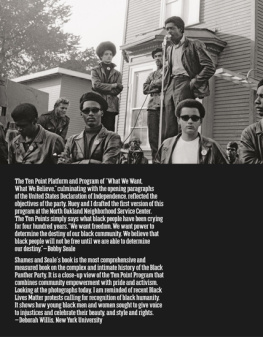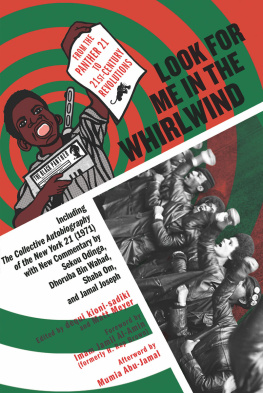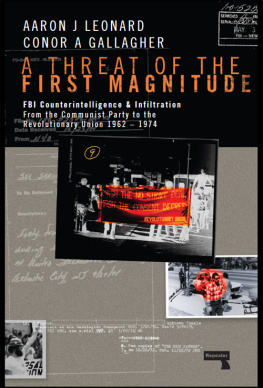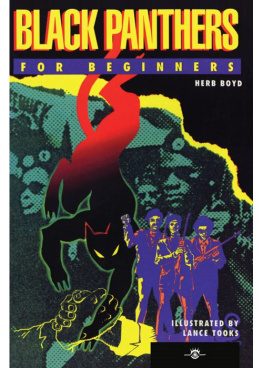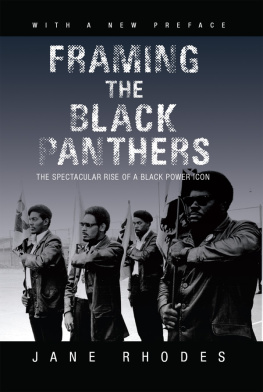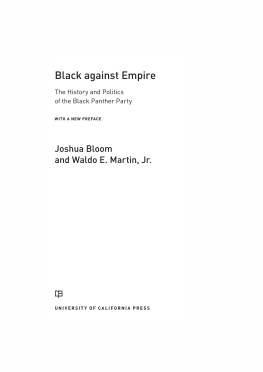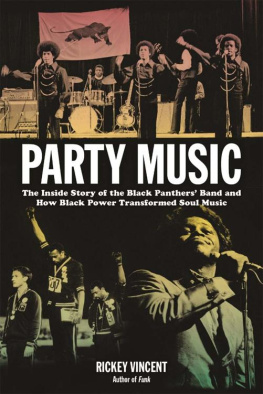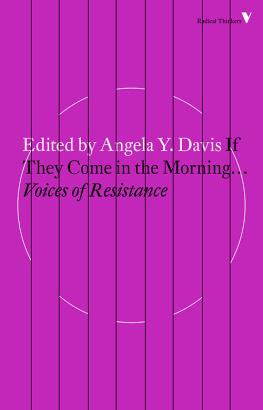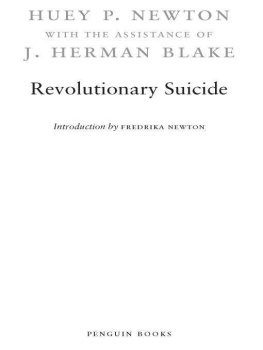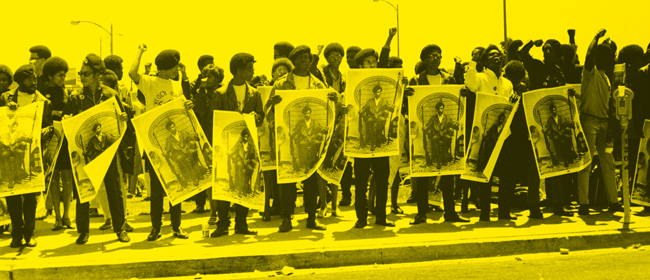
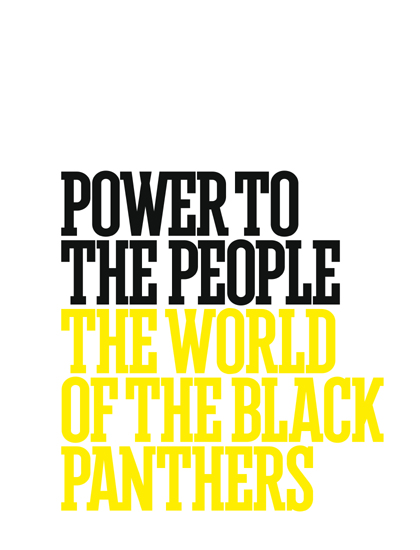


A teenager wears a Bobby Seale button on his hat to show his support, Chicago, 1970
Contents

The window of Black Panther Party National Headquarters at Grove and Forty-fifth Streets in Oakland after shots were fired by police following Huey Newtons murder trial verdict, September 29, 1968
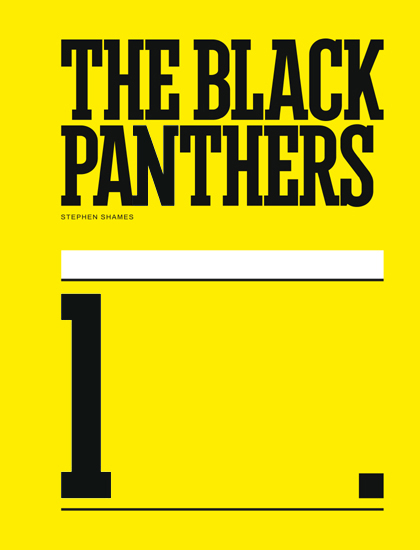

Student, Intercommunal Youth Institute, Oakland
When I give food to the poor, they call me a saint. When I ask why the poor have no food, they call me a communist.
HLDER CMARA
Like many boys of my generation, I built myself a radio receiver from a kit. Every night I crawled under the covers with an earphone (so my parents would not know I was still awake) and listened to music and the very popular comedy show Amos n Andy.
Today Amos n Andy seems like a bad joke, but nobody in my 1950s Father Knows Best world thought this program was an inaccurate depiction of black Americans. My eight-year-old brain had no other reality to compare it with. Despite the landmark 1954 Brown v. Board of Education decision, when the U.S. Supreme Court under Chief Justice Earl Warren, the Republican former governor of California, decided unanimously that public schools could no longer be segregatedthat separate but equal was no longer the law of the landnothing much had changed. This momentous decision, which overturned a century of legal opinion, did not have any effect that my youthful eyes could see. No black children or teachers entered my primary school. No African American families moved in next door. The America of my childhood remained deeply segregated.
Bobby Seale and Huey Newton also came of age in a segregated America. Born in the SouthHuey in 1942 in Monroe, Louisiana; Bobby in 1936 in Liberty, Texasboth participated in the second migration of African Americans when their families moved to California: Hueys to Oakland in 1945, when he was three, and Bobbys to Berkeley in 1944, when he was eight. While moving out of the South provided some degree of economic advancement, relocating in the West did not allow Huey and Bobby to escape racism, poverty, and inferior schools.
In his autobiography, Revolutionary Suicide, Huey remembered, that I constantly felt uncomfortable and ashamed of being black. He wrote, During those long years in Oakland public schools, I did not have one teacher who taught me anything relevant to my own life or experience. Not one instructor ever awoke in me a desire to learn more or to question or to explore the worlds of literature, science, and history. All they did was try to rob me of the sense of my own uniqueness and worth, and in the process nearly killed my urge to Huey was illiterate when he graduated from Oakland Technical High School in 1959. He taught himself to read by studying Platos Republic.
Bobbys family lived in poverty during most of his childhood. He recalls, I was raised in Berkeley, California, in the old University Village, in the government projects built during World War II. Bobby attended Berkeley High School but dropped out and joined the U.S. Air Force in 1955. There he became a structural repairman on high-performance aircraft. He earned his high school diploma at night while working as a sheet metal mechanic at various aerospace plants. Then, until 1962, Seale attended Merritt College in Oakland, where he studied engineeringand met Huey.
Bobby Seale and Huey Newton founded the Black Panther Party for Self-Defense in October 1966. From its original six members, the Panthers grew into a political organization of more than ten thousand men and women in forty-nine chapters. Their legacy continues to inspire today, fifty years later.

Harlem, 1970
My Involvement with the Panthers
In 1966, I was a student at the University of California at Berkeley. One of my roommates, Marty Roysher, had been on the steering committee of the Free Speech Movement the year before. With his guidance I became active in student government and the antiVietnam War movement. In August 1967, after a summer job at a plastics factory, I hitchhiked to the East Village of New York City. I bought my first camera during the Summer of Love. When I returned to Berkeley in September, I realized I was not suited for the endless meetings and bickering of politics. My contribution to the movement would be as a photographer. Documenting the Black Panthers became my first long-term project.
The first time I saw Bobby Seale and Huey Newton was on April 15, 1967, during the Spring Mobilization to End the War in Vietnam. My father had come up from Los Angeles, and we were marching together through the streets of San Francisco when my eye caught Bobby and Huey in their leather jackets selling Maos Little Red Book. Their charisma and confidence captivated me. I took one frame.
I started hanging out with the Panthers, attending their rallies. Bobby Seale became my mentor and friend. He introduced me to David and June Hilliard, Elbert Big Man Howard, Kathleen and Eldridge Cleaver, Emory Douglas, and Bobbys brother, John. I was granted incredible access. Over the next seven years, culminating in Bobby Seales 1973 campaign for mayor of Oakland, I documented this group of young men and women, who were at the forefront of the Black Power movement and who became the vanguard of the revolution that was sweeping America.
What Was the Black Panther Party?
The Black Panther Party was a revolutionary political organization. Although its members were leaders of the Black Power movement, they were not black nationalists. Their black pride was not based on denigrating whites, but on showing the black community how to take control of its own destiny. The Black Panther Party worked for economic justice and power for all people.
Bobby Seale explains, The Black Panther Party was an All Power to All the People! organization. It was a powerful grassroots activist organization that formed coalitions seeking to further our civil human rights and achieve real freedom and justice for all the people. These were the political revolutionary objectives of my Black Panther Party.
In their landmark book, Black against Empire, Joshua Bloom and Waldo E. Martin Jr. wrote:
What is unique and historically important about the Black Panther Party is specifically its politics.... They created a movement with the power to challenge established social relations.... From 1968 through 1970, the Black Panther Party made it impossible for the U.S. government to maintain business as usual,
Next page
